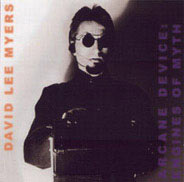
David Lee Myers
Arcane Device – Engines Of Myth
(ReR)
With
its bizarre cover in black, yellow and orange, sporting an artist’s name that
was totally unknown to me, Arcane Device 1 – Engines Of Myth was one of the
most intriguing surprises of 1988, the year when the vinyl LP was originally
released. Interestingly, the cover talked of "feedback music" –
i.e., as was explained (?), of "Improvisations for feedback within/between
time delay electronics, recorded live to tape". The cover also mentioned
New York as the place where the artist resided.
"Feedback
within/between time delay electronics" meant exactly this – that the
system lacked any input signal. An idea that – for this writer, at least –
was quite new and stimulating – but not really clear. But an article by Myers
himself – called A ‘Personal System’ For Electronic Music, it appeared on
Volume 2 Number 3 of the much lamented Re Records Quarterly Magazine – made
everything easily comprehensible.
It’s
quite obvious that the fact that the idea was new would have been worthless
by itself if the aesthetical results had not been so stimulating. But the
music was fresh and with a very clear form (is the word "organized"
ok?) – which was definitely not to be taken for granted, given the fact that
the whole system had a high level of randomness, hence the results were by
necessity pretty different.
The
first tracks of the album – Lathe, Engine Of Myth, Mg 24.312, all with a high
dramatic quotient – reminded me of one of my heroes, the seldom mentioned
USA innovator Tod Dockstader – and not exactly by chance, since a dedication
to him appeared on the LP cover.
The
whole album rewarded repeated listening, from the "muezzin" featured
in Prayer Cloth to the long closing track titled Deaf Men Hear No Tales, to
the strange Bowie-like echoes of Pink Porous Rock.
Some
time later, a double 45 called Arcane Device 3 – Improvisations For Feedback
updated the story: two tracks in the studio, two tracks live – the latter
tracks especially giving a clear idea of the possibilities.
A
few years later I heard other things by Myers, but to me none seemed to possess
the dry, clear quality of that album, which meanwhile had become pretty difficult
to find. Now you can listen to it (quite literally, I’d say, since the CD
seems to come from an LP transfer – but fear not: sound’s excellent, the dynamic
range very good), plus the aforementioned double single.
I would have liked to find reproduced here that article by Myers – maybe I’m
the only one who regards this things as being important?
Beppe
Colli
©
Beppe Colli 2003
CloudsandClocks.net
| Oct. 7, 2003


